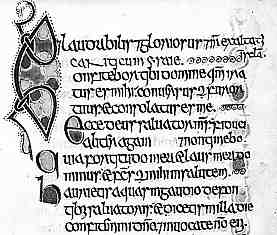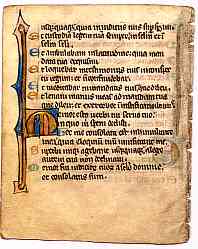




If you are looking at this page without frames, there is more information about medieval writing to be found by going to the home page (framed) or the site map (no frames).
| The Psalter (4) | ||||
 |
Segment from a 13th century Irish Psalter (British Library, add. ms. 36929, f.67), by permission of the British Library. | |||
| One might be tempted to believe that this example is much older than it is, with its insular minuscule script and conservative Irish decorative initials, but such details were retained in Ireland for centuries as a homage to their ethnic individuality. The basic layout is still there, with the enlarged capitals, bold script and line fillers. | ||||
 |
Page from a 13th century Flemish psalter, from a private collection. | |||
| This very small page from a portable psalter is grubby with use, and the gold leaf of the main initial has partially rubbed off, revealing the gesso beneath. It has been around. While small and relatively plain, it has the basic format, although it lacks line fillers. An interesting detail is that it appears that certain punctuation marks, accents, and fine sloping dots over i have been added in a different ink. It seems that it has been marked up for reading aloud, and for ease of comprehension. I like to think of it having been packed up in the saddlebag of a wandering Dominican, along with his portable Bible, in order to sort out the heretics, but I may be letting my imagination get carried away here. | ||||
 |
Detail showing a few of the added punctuation and other markings. | |||
| The mark which looks like a tick over a dot has been inserted in numerous places, as well as the diagonal slashes. On the original they are easily distinguishable from the original punctuation and abbreviation marks, but that does not show so well on the digital version. | ||||
| Right through the middle ages, the psalter was essentially a highly significant written text, and one assumes there must have been many plain versions just for study. | ||||
 |
Leaf from a psalter of around 1500 from Germany, from a private collection. | |||
| This plain vanilla example of a psalter text is written in a rather rough and untidy Gothic textura, clear enough but not particularly elegant. The expansive layout of the psalter for reading aloud has been abandoned for crammed lines of text, which contains numerous abbreviations. The only locating aids are alternating red and blue capitals of very plain form. To my mind this is unlikely to be a service book as such, but a text for reference, study, learning and contemplation. The words are everything. | ||||
| Segment of a leaf from a bilingual psalter of the late 15th or early 16th century, from a private collection. |  |
|||
| It has been suggested that by the end of the medieval era, the clergy had become less adept at Latin than their forebears. The example above provides an intriguing little piece of evidence. It is from a psalter which has been written in a small cursive hand, clear, but not amazingly formal. Each line is written first in Latin, then in French. In the Latin text there are little red accent marks which look like pronunciation guides. It appears to be a learning text for the Latin psalter for French speakers. | ||||
| The contents of the psalter were extracted and presented in different forms in various other liturgical books which represented the public performance of the work. The contents were re-ordered and contextualised among other liturgical elements in the missal and the breviary, and sometimes set to music. The gradual, antiphoner and processional specifically privileged those musical elements. The text is not one of teaching, parable or moral history, but of joyful celebration. It represents the primary work of a Benedictine monk, and was central to all the celebrations of the church. In the later middle ages, when the laity participated in their own personal devotions through the performance of the Hours of the Virgin, as presented in the book of hours, selections from the psalter text formed the basis for their devotions. | ||||
| |
||||
If you are looking at this page without frames, there is more information about medieval writing to be found by going to the home page (framed) or the site map (no frames). |
||||